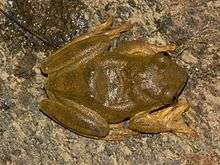Red tree frog
| Leptopelis rufus | |
|---|---|
 | |
| Scientific classification | |
| Kingdom: | Animalia |
| Phylum: | Chordata |
| Class: | Amphibia |
| Order: | Anura |
| Family: | Arthroleptidae |
| Subfamily: | Leptopelinae |
| Genus: | Leptopelis |
| Species: | L. rufus |
| Binomial name | |
| Leptopelis rufus Reichenow, 1874 | |
| Synonyms[2] | |
|
Hylambates rufus (Reichenow, 1874) | |
The red tree frog, Leptopelis rufus, is a species of frog in the family Arthroleptidae.[2][3][4] It is found in southeasternmost Nigeria, western Cameroon, Equatorial Guinea, western Gabon, the lower Republic of the Congo, the lower Democratic Republic of the Congo, and northwestern Angola. It has been confused with several other species, in particular with the palm forest tree frog Leptopelis palmatus.[2]
Description
Adult males measure 45–55 mm (1.8–2.2 in) and females 74–87 mm (2.9–3.4 in) in snout–vent length. The dorsum is brown with darker irregular transverse bars. The tibia have 3–4 bars. The feet are fully webbed. The iris is golden. The tympanum is a rather small, a characetristic that separates it from similar species like Leptopelis palmatus and Leptopelis macrotis.[3][4]
The male advertisement call is a series (about ten) long "yiin" cries. A male approaching a female may emit a different, quiet call, sounding like the meow of a young cat.[3][4]
Habitat and conservation
This arboreal species' inhabits humid lowland rainforests. It also occurs in secondary forests.[1] The males call from branches in the forest or from Raphia palms, typically above small streams. A pair in copula was found in the low vegetation near a small stream.[3][4] Presumably, the eggs are laid in nests on land close to the water.[1]
Leptopelis rufus is a reasonably common species, but it is affected by habitat loss caused by expanding human settlements and agriculture as well as harvesting of wood. It occurs in a number of protected areas, including the Korup National Park (Cameroon) and Monte Alén National Park (Equatorial Guinea).[1]
References
- 1 2 3 4 Schiøtz, A.; Amiet, J.-L.; Burger, M.; Fretey, T. (2004). "Leptopelis rufus". IUCN Red List of Threatened Species. IUCN. 2004: e.T56280A11439867. Retrieved 10 January 2016.
- 1 2 3 Frost, Darrel R. (2016). "Leptopelis rufus Reichenow, 1874". Amphibian Species of the World: an Online Reference. Version 6.0. American Museum of Natural History. Retrieved 9 November 2016.
- 1 2 3 4 "Leptopelis rufus Reichenow, 1874". African Amphibians. Retrieved 9 November 2016.
- 1 2 3 4 "Leptopelis rufus ". AmphibiaWeb: Information on amphibian biology and conservation. [web application]. Berkeley, California: AmphibiaWeb. 2008. Retrieved 9 November 2016.
| Wikimedia Commons has media related to Leptopelis rufus. |
